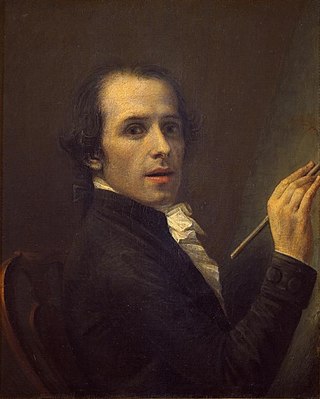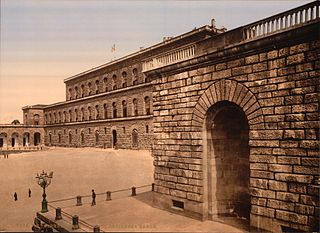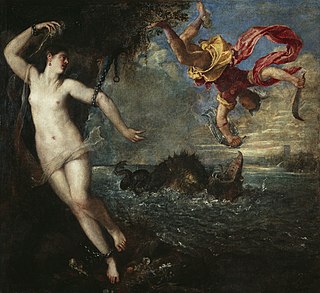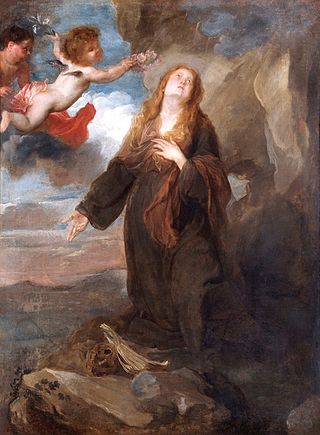
Antonio Canova was an Italian Neoclassical sculptor, famous for his marble sculptures. Often regarded as the greatest of the Neoclassical artists, his sculpture was inspired by the Baroque and the classical revival, and has been characterised as having avoided the melodramatics of the former, and the cold artificiality of the latter.

Duke of Wellington is a title in the Peerage of the United Kingdom. The name derived from Wellington in Somerset. The title was created in 1814 for Arthur Wellesley, 1st Marquess of Wellington, the Anglo-Irish military commander who is best known for leading the decisive victory with Field Marshal von Blücher over Napoleon's forces at Waterloo in Brabant. Wellesley later served twice as British prime minister. In historical texts, unqualified use of the title typically refers to the 1st Duke.

Apsley House is the London townhouse of the Dukes of Wellington. It stands alone at Hyde Park Corner, on the south-east corner of Hyde Park, facing towards the large traffic roundabout in the centre of which stands the Wellington Arch. It is a Grade I listed building.

The Fitzwilliam Museum is the art and antiquities museum of the University of Cambridge. It is located on Trumpington Street opposite Fitzwilliam Street in central Cambridge. It was founded in 1816 under the will of Richard FitzWilliam, 7th Viscount FitzWilliam (1745–1816), and comprises one of the best collections of antiquities and modern art in western Europe. With over half a million objects and artworks in its collections, the displays in the museum explore world history and art from antiquity to the present. The treasures of the museum include artworks by Monet, Picasso, Rubens, Vincent van Gogh, Rembrandt, Cézanne, Van Dyck, and Canaletto, as well as a winged bas-relief from Nimrud. Admission to the public is always free.

The Wallace Collection is a museum in London occupying Hertford House in Manchester Square, the former townhouse of the Seymour family, Marquesses of Hertford. It is named after Sir Richard Wallace, who built the extensive collection, along with the Marquesses of Hertford, in the 18th and 19th centuries. The collection features fine and decorative arts from the 15th to the 19th centuries with important holdings of French 18th-century paintings, furniture, arms and armour, porcelain and Old Master paintings arranged into 25 galleries. It is open to the public and entry is free.

The Palazzo Pitti, in English sometimes called the Pitti Palace, is a vast, mainly Renaissance, palace in Florence, Italy. It is situated on the south side of the River Arno, a short distance from the Ponte Vecchio. The core of the present palazzo dates from 1458 and was originally the town residence of Luca Pitti, an ambitious Florentine banker.

The Alte Pinakothek is an art museum located in the Kunstareal area in Munich, Germany. It is one of the oldest galleries in the world and houses a significant collection of Old Master paintings. The name Alte (Old) Pinakothek refers to the time period covered by the collection—from the fourteenth to the eighteenth century. The Neue Pinakothek, re-built in 1981, covers nineteenth-century art, and Pinakothek der Moderne, opened in 2002, exhibits modern art. All three galleries are part of the Bavarian State Painting Collections, an organization of the Free state of Bavaria.

Diana and Actaeon is a painting by the Italian Renaissance master Titian, finished in 1556–1559, and is considered amongst Titian's greatest works. It portrays the moment in which the hunter Actaeon bursts in where the goddess Diana and her nymphs are bathing. Diana is furious, and will turn Actaeon into a stag, who is then pursued and killed by his own hounds, a scene Titian later painted in his The Death of Actaeon.

The National Gallery is the primary British national public art gallery, sited on Trafalgar Square, in central London. It is home to one of the world's greatest collections of Western European paintings. Founded in 1824, from an initial purchase of 36 paintings by the British Government, its collections have since grown to about 2,300 paintings by roughly 750 artists dating from the mid-13th century to 1900, most of which are on display. This page lists some of the highlights of the collection.

Diana and Callisto is a painting completed between 1556 and 1559 by the Italian late Renaissance artist Titian. It portrays the moment in which the goddess Diana discovers that her maid Callisto has become pregnant by Jupiter. The painting was jointly purchased by the National Gallery and the Scottish National Gallery for £45 million in March 2012. Along with its companion painting Diana and Actaeon it is displayed on an alternating basis between London and Edinburgh. There is a later version by Titian and his workshop in the Kunsthistorisches Museum in Vienna.

The Death of Actaeon is a late work by the Italian Renaissance painter Titian, painted in oil on canvas from about 1559 to his death in 1576 and now in the National Gallery in London. It is very probably one of the two paintings the artist stated he had started and hopes to finish in a letter to their commissioner Philip II of Spain during June 1559. However, most of Titian's work on this painting possibly dates to the late 1560s, but with touches from the 1570s. Titian seems never to have resolved it to his satisfaction, and the painting apparently remained in his studio until his death in 1576. There has been considerable debate as to whether it is finished or not, as with other very late Titians, such as the Flaying of Marsyas, which unlike this has a signature, perhaps an indication of completion.

Napoleon as Mars the Peacemaker is a colossal heroic nude statue by the Italian artist Antonio Canova, of Napoleon I of France in the guise of the Roman god Mars. He holds a gilded Nike or Victory standing on an orb in his right hand and a staff in his left. It was produced between 1802 and 1806 and stands 3.45 metres to the raised left hand. Once on display in the Louvre in Paris, it was purchased from Louis XVIII in 1816 by the British government, which granted it to the Duke of Wellington. It is now on display in Robert Adam's stairwell at the Duke's London residence, Apsley House.

The Venetian painter Titian and his workshop made at least six versions of the same composition showing Danaë, painted between about 1544 and the 1560s. The scene is based on the mythological princess Danaë, as – very briefly – recounted by the Roman poet Ovid, and at greater length by Boccaccio. She was isolated in a bronze tower following a prophecy that her firstborn would eventually kill her father. Although aware of the consequences, Danaë was seduced and became pregnant by Zeus, who, inflamed by lust, descended from Mount Olympus to seduce her in the form of a shower of gold.

The Portrait of the Duke of Wellington is a painting by the Spanish artist Francisco de Goya of the British general Arthur Wellesley, 1st Duke of Wellington, during the latter's service in the Peninsular War. One of three portraits Goya painted of Wellington, it was begun in August 1812 after the subject's entry into Madrid, showing him as an earl in an all-red uniform and wearing the Peninsular Medal. The artist then modified it in 1814 to show him in full dress uniform with black gold–braided lapels and to add the Order of the Golden Fleece and Military Gold Cross with three clasps.

The Chelsea Pensioners reading the Waterloo Dispatch, originally entitled Chelsea Pensioners Receiving the London Gazette Extraordinary of Thursday, June 22, 1815, Announcing the Battle of Waterloo, is an oil painting by David Wilkie, commissioned by Arthur Wellesley, 1st Duke of Wellington in August 1816.

Perseus and Andromeda is a painting by the Italian Renaissance artist Titian, now in the Wallace Collection in London. It was painted in 1554–1556 as part of a series of mythological paintings called "poesie" ("poetry") intended for King Philip II of Spain. The paintings took subjects from the Roman poet Ovid's Metamorphoses, in this case Book IV, lines 663–752, and all featured female nudes.

Saint Rosalia Crowned by Angels is a c. 1625 oil on canvas painting by Anthony van Dyck, one of five surviving works showing the saint which he produced whilst he was quarantined in Palermo, Sicily due to a plague. It is now in the Wellington Collection at Apsley House in London.

The Sèvres Egyptian Service is a name used for two sets of tableware made by the Manufacture nationale de Sèvres during the First French Empire. The first was produced between 1804 and 1806 for Napoleon I and was presented by him to Alexander I of Russia in 1808, as a diplomatic gift following the Treaties of Tilsit. It is now held in the State Museum of Ceramics in Russia.

Titian's Mistress, also known as An Unknown Lady, is an oil painting variously attributed to Titian, his workshop, or both. It was painted in about 1550 or 1560. The painting is part of the Wellington Collection at Apsley House in London.

Portrait of the Duke of Wellington is a portrait painting by the English artist Thomas Lawrence of the Anglo-Irish soldier and politician the Duke of Wellington. It was begun in early 1815 following Wellington's success in the Peninsular War and shortly before his victory over Napoleon at the Battle of Waterloo and the subsequent allied occupation of France under Wellington's command. It is now in the collection of Apsley House, the Duke's London residence. Wellington is shown in military uniform displaying various honours including the Order of the Garter, the Order of the Golden Fleece and the Order of the Bath. He has been described as "impassive and aloof" in the painting. Lawrence's depiction of Wellington was used on the British five pound note between 1971 and 1991.























